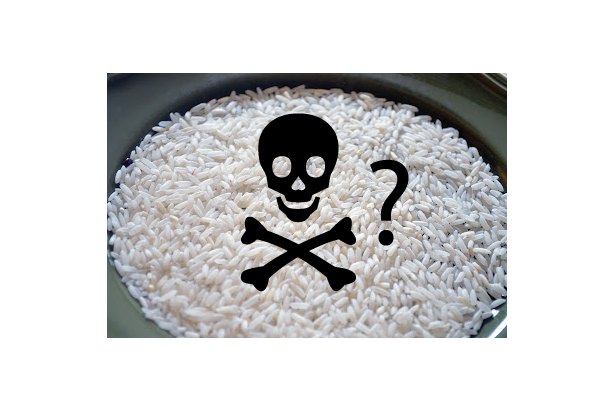 In light of yesterday’s post on rice, a few of you raised the ol’ arsenic concern.
In light of yesterday’s post on rice, a few of you raised the ol’ arsenic concern.
Listen, it’s a valid concern.
Who wants to knowingly & willing consume carcinogens?
If you aren’t aware of the arsenic & rice (not to be confused with arsenic & lace) issue, let me get you up to speed. (Well really, just read this.) But essentially, low-levels of arsenic have been found in all crops of rice–brown, white, wild, regardless of the country they are grown, regardless of the farming methods (ie. doesn’t matter if it’s organic or not).
Say what? Arsenic in our food?!
This little bit from the FDA website explains more:
Arsenic is a chemical element distributed in the Earth’s crust. Human activities such as fuel burning, mining and the use of arsenic compounds in pesticides have also added arsenic to the environment.
Though, they do point out that “[…] Even if you stripped all human contributions, there would still be arsenic in food.” (italics added)
And it’s not just in the rice. It’s been found in apple & grape juice. And chicken (which some has up to 10 times the amount found in apple juice).
No problem! you say.
I’ll just eat quinoa, wheat, millet, or potatoes.
But hold up.
These foods aren’t entirely void of issues either:
- Quinoa: Our demand for quinoa is causing violence & food shortages in Bolivia, where half the world’s quinoa is grown
- Wheat: Contains gluten, which for many intolerant or Celiac folks, is a problem, not to mention the issues of hybridization
- Millet: Not the most accessible food (at least in the United States)–most of the millet available to us has to be imported
- Potatoes: Very high pesticide & herbicide use (& organic potatoes–not always an option)
- Sweet Potatoes: Not always in season, hard to find in some markets, & short shelf-life
Just in case you wanted more information to make you more confused & conflicted & give you cause to lose sleep at night, there are all those other foods that are wrapped in controversy–chocolate, palm oil, tomatoes, bananas, soy, corn, peanuts, nuts, the list goes on.
Also, for more anxiety, think about issues of fair trade, GMO’s, pesticide & herbicide use, hybridization of crops. I’m not saying these issues aren’t important to consider, only that if you let this anxiety overtake you, it can paralyze you from going forward & making the best choices you can with the information that you have.
(I found this article on chocolate, coffee, & tomatoes helpful, & regarding the palm oil issue, Colleen Patrick-Goudreau delivers a thorough & well-thought out argument & synopsis on the topic, here.)
So what’s a person to do?
Only eat fruit? Only eat vegetables (those have plenty of contaminants/toxins too)? Only eat food from your garden (wouldn’t that be nice)?
Once you start to go down the alarmist’s path, you can easily eliminate most foods from your diet, which is not recommended for obvious reasons. (And on that note, Somer writes a thoughtful post on deprivation diets, which is not entirely unrelated to the topic at hand.)
I think the best approach is to weigh your opportunity costs with education & a good amount of common sense.
The fact is, I need to eat & am limited in my time & financial resources. So I ask myself:
What can I eat that will fuel my body without breaking the bank (& not just that, but help our family get out of debt), while taking on the least amount of risk to my health & harm to the environment, animals, & my fellow humans?
The answer for me, is: a varied, mostly whole plant foods-based diet (rice included!) which can be quite affordable (even frugal) & health promoting.
More specific to the rice question (should you eat it?), I found these excerpts from the FDA website helpful:
The approximately 1,300 analytical results do not tell us what long-term health effect, if any, these levels may have, nor do they tell us what can be done to reduce these levels. The data collection and analysis is the first step in a major effort to understand the overall safety of consumption of rice and rice products in the United States.
I would underscore the “if any” part. Even the FDA indicates that they do not know the long-term health effects to exposure of arsenic at very low levels. There may be some risk, a lot of risk (not likely, considering the high amount of populations consuming rice for every meal without many obvious or proven negative side effects), or little to no risk at all.
I’m not saying there is no risk to eating rice (the fact is, there are very few risk-free food choices in our world), but the reality is there are far more higher risk food choices that should take precedence over concerns about arsenic in our food–ahem, our meat consumption! (says the vegetarian).
Other helpful excerpts from the FDA website:
Can the consumer do anything to offset or reduce the arsenic in rice?
The FDA recommends that consumers eat a well-balanced diet that includes a variety of grains for good nutrition and to minimize potential adverse consequences from consuming an excess of any one particular food.
What is FDA recommending to consumers about eating rice and rice products?
Based on the currently available data and scientific literature, FDA’s advice for consumers, including pregnant women, is to eat a well-balanced diet for good nutrition and to minimize potential adverse consequences from consuming an excess of any one food. Additionally, parents should follow the advice of the American Academy of Pediatrics and feed their infants and toddlers a variety of grains as part of a well-balanced diet […]
Rice is an important staple for many people, and the arsenic levels that FDA found in the samples it evaluated were too low to cause any immediate or short-term adverse health effects. All consumers, including pregnant women, infants and children, are encouraged to eat a well-balanced diet for good nutrition and to minimize potential adverse consequences from consuming an excess of any one food.
The take away from my view—
There’s not enough evidence to suggest that eating rice as part of a varied*, well-balanced diet is anything I should avoid.
*Meaning, I’m not unduly relying on just one or two foods to meet my nutritional needs.
I think the Consumer Reports suggestions (only eat rice TWICE a week–that’s a slap in the face to most Asian, South American & Middle Eastern cultures in which rice is the basis of their diets) are on the ultra-conservative side. Frankly, unnecessarily drastic.
All foods contain various levels of toxins & carcinogens, most at levels that are negligible.
If we’re looking for a 100% pure, toxin-free, carcinogen-free food, we’ll be hard pressed to find many. Apple & grape juices have been found to contain higher levels of arsenic than rice, & chicken has been found to have 10 times the amount of apple juice (& I’m pretty sure Americans eat a lot more chicken than they do rice).
The arsenic in rice issue isn’t a new one (I mean, it didn’t just happen in the last decade). There are many cultures that eat rice for every meal (in fact, that may be the case for half the world’s population, even if it isn’t the case for Americans) & have done so for centuries & centuries without much of a hitch.
Figuring out what to eat seems like a minefield, but I think considering the current information I have from the FDA (who arguably has done the most scientific research on the topic) & other sources, the risks associated with eating rice as part of a varied, nutrient-dense, plant-based diet are very, very low.
And it’s a low-risk I’m willing to take.



Comments